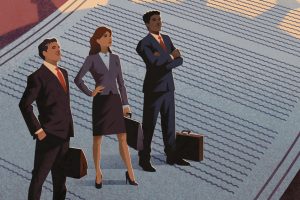By Linda K. Stone
Try your hand at Social Security reform with this revamped Academy tool.
Social Security is back in the news, due to a focus on entitlement spending such as Social Security and Medicare in the ongoing congressional debt ceiling and budget debates. Social Security makes up 21% of the federal budget. Some politicians are looking at changes to Social Security as part of the solution. With Social Security trust fund reserves expected to be depleted by 2035—leading to a 20% cut in benefits if Congress doesn’t take any action—focus on Social Security is warranted. Bipartisanship will be necessary, as Social Security spending levels are set by law.
When we say that Social Security will become insolvent, what are we really saying? If you watch the news, it is clear there is a misunderstanding of what this means for those who rely on Social Security (currently 65 million Americans are receiving Social Security benefits) and those who are expecting to receive Social Security benefits in the future. In 2035, Social Security reserves are expected to be depleted, generally leaving only payroll (also known as FICA) taxes to pay benefits. Between now and 2035, these reserves (built up by years of taxes and other Social Security income exceeding the benefits and administrative costs to run the system) are being drawn down to pay earned benefits. When the reserves are depleted, benefits don’t go to zero, as some may believe. Instead, payroll taxes will only be able to pay 80% of these benefits, so if someone was previously getting $1,000 a month, their check would be cut to $800 a month. This sizable reduction would be a hardship for the majority of people who rely on Social Security benefits for their financial security in retirement. To illustrate, one in two recipients get 50% or more of their income in retirement from Social Security. The other alternative would be to raise payroll taxes from the current level of 6.2% of pay (paid by employer and employee) to 7.8% of pay, which would be hard for many workers to afford.

How did Social Security finances get to this challenging state? The answer is primarily one of demographics—the baby boomers moving into and through the retirement zone (10,000 boomers turn 65 every day) with fewer workers behind them due to lower fertility rates. Increasing life expectancy is also a factor; 65-year-olds generally live about six years longer than they did at the start of Social Security. There are now about three workers for every beneficiary, dropping to two workers per beneficiary by 2050. Economic considerations, such as decreases in real wage growth, play a part as well.
In order to keep Social Security strong and able to pay earned benefits, members of Congress have three levers to pull. They can increase payroll taxes, reduce benefits, or some combination of both. Republicans and Democrats over the years have put forth various proposals to address Social Security’s finances. These proposals shift the balance between individual equity and social adequacy (see sidebar, page 21), each in their own way.

In recognition of the importance of this issue for American’s retirement security, the Academy has been providing objective analysis on Social Security solvency issues and reform options for many years. We have done this, for example, by releasing a monograph on the individual equity and social adequacy underpinnings of Social Security and issue briefs analyzing tax and benefit reform options, by holding webinars wherein experts from across the political spectrum provide their perspectives, and by holding “Hill visits” with congressional staffers to share work products and hear their opinions. The Academy’s work provides all sides and perspectives with relevant issues identified and implications both positive and negative noted.
In order to engage the public on this policy issue in which they all have a stake, the Academy in 2005 created and hosts the Social Security Game on its website. This engaging and educational tool can be used to inform the general public and other stakeholders about the current status of the Social Security trust funds. Users learn about possible reform options to bring the system into long-term balance by selecting options and seeing how much those options would “solve” the solvency challenge.
Now in 2023, the Academy is pleased to announced a revamped and renamed tool, now called the Social Security Challenge. As mentioned above, with Social Security making headlines again, now seems the optimal time to reengage the public on the importance and timeliness of addressing Social Security reform. The Academy is in the perfect position to do so, as we provide objective analysis and perspective to inform this policy discussion. It is important for the American public to engage in the debates that are happening as Social Security is critical to their retirement security. Through the Challenge, they can see that there are no easy answers and that most reform options could impact them and their families.
One enhancement to the Challenge (vs. the Game) is to include some reform options that actually increase Social Security costs. Some members of Congress have proposed provisions that address perceived weaknesses of the current structure, such as the number of recipients who are in poverty. Also, due to societal changes since Social Security’s inception—the marked increase in the number of working women, as an example—changes to the current spousal benefits have been proposed. Changes to survivor benefits have also been proposed as widows/widowers can get their combined Social Security benefits reduced by up to 50% when their spouse dies.

The Academy partnered with an interactive developer to create a user experience that is immersive and fun. In the Challenge, the user will visit “Townsville” and select specific locations—the park, the gym, a grocery store, and a coffee shop (where the local actuary stops by!). They will meet everyday Americans going about their lives and sharing their stories and thoughts with one another about various Social Security options and their potential impact. Users will hear from different generations and those in different life circumstances. They can pop into the local talk show where a spirited discussion about raising Social Security’s normal retirement age is occurring. (Not surprisingly, the panelists have some differences of opinion.)
The activity starts with educational information about the foundations of Social Security, the status of the trust funds and the concepts of individual equity and social adequacy. As the user visits each location, they can click on the location in their journal for additional information about the specific topic being discussed. The journey through Townsville ends at Town Hall, where the residents are engaging in a discussion of various reform options.

Next, the user can engage in the Challenge activity, selecting various Social Security provision options and seeing the impact on Social Security solvency to keep it strong for now and for generations to come.
Changes are grouped into several categories (with several options for each), such as cost-of-living adjustments (COLAs); the normal retirement age (NRA) (currently 67 for most American workers); changing the benefit formula; worker’s payroll tax rate and ways to get additional revenue for Social Security such as taxing investment income. The financial impact estimates shown are from the Office of the Chief Actuary Summary of Provisions That Would Change the Social Security Program released in September 2022. The Academy will update these impacts each year as new information is released.
For example, as noted above, the Challenge can be completely solved by immediately raising the payroll tax rate paid by workers and their employers. If this solution seems untenable and burdensome, users can select the option to raise it over time by 0.1% per year until it is 7.2% in 2047. This choice will solve 44% of the problem. If the next option selected is to increase the NRA by two months a year until it is age 68, the total solved becomes 59% as the NRA option is worth 15%. So, the user will see that additional changes would still be needed and could continue to add other options. If options that would increase Social Security costs are selected (such as increasing the minimum benefit to 125% of the poverty level [indexed] for those who have worked for at least 30 years), then additional benefits cuts/tax increases would need to be selected to compensate for the increases.

Users will quickly grasp that there are no easy fixes and that a combination of different changes that impact many Americans will likely be needed to keep Social Security in good financial shape. Going through the options can inform and change minds. The activity can also debunk assumptions, such as the idea that the only solution needed would be to remove the tax and benefits base (currently about $160,000) so that payroll taxes are applied on all earnings. This particular change will get to 75% of the solution as long as no benefit credit is given on those taxed earnings—a change in the current linkage between taxes paid and benefit credit given. With the demographic headwinds noted earlier, actual changes to Social Security’s benefits and/or payroll taxes are necessary. There is no other option available.
It is beneficial for Congress to act sooner rather than later, as there will be more options to choose from and the burden of any changes can be more easily shared across generations. If changes are made now that become effective in the future, people will have more time to adjust to these changes. It is important to restore confidence in the Social Security system and its ability to continue to be such an important part of American’s retirement financial security.

The goal of the Academy in developing, hosting, and sharing the Social Security Challenge with as wide an audience as possible is for the general public and other stakeholders to understand the issues behind Social Security’s financial challenges and the various options to address them. With the public discourse around Social Security only expected to grow louder and more frequent over the coming months and years, it is important for Americans to have the information to judge for themselves the accuracy about what they are hearing—and to be able to participate in this dialogue with their families, neighbors, and elected representatives.
So, take a walk around Townsville and start talking about Social Security!
LINDA K. STONE, MAAA, FSA, is the senior pension fellow at the Academy.
The Principles of Individual Equity and Social Adequacy
Three features of Social Security incorporate the principle of individual equity:
- Benefits are paid regardless of need.
- Payroll tax rates are a flat percentage of income up to a maximum annual amount, so that workers of all income levels pay the same rate.
- Benefits are determined by a formula that provides higher amounts for workers who have contributed more to the system.
These three features are sometimes characterized by the terms “universality” and “earned right.” Universality means that the system covers nearly all workers across the entire earnings spectrum and everyone contributes toward those benefits at the same rate. The fact that even the very wealthy receive Social Security helps prevent benefits to the less well off from being stigmatized as welfare payments. Earned right means that a worker’s entitlement to a Social Security benefit derives from the worker’s employment and from the payroll taxes paid on earnings rather than from financial need. Together, the concepts of universality and an earned right to a benefit distinguish the program from needs-based programs such as Medicaid and SNAP (Supplemental Nutrition Assistance Program, formerly known as Food Stamps), thereby contributing to more widespread and enduring public support for Social Security.

Social Security adheres to the principle of social adequacy in the following ways:
- The program replaces a portion of a worker’s income from employment when the worker either retires due to age or is deemed unable to work due to a qualified disability.
- The program pays benefits to others previously dependent on the worker’s employment income, such as the worker’s spouse and, in some circumstances, children and parents, both while the worker is still living and after the worker has died, provided the beneficiary is not eligible for higher benefits based on his or her own earnings histories.
- The program replaces a higher portion of pre-retirement income for lower-income workers and their dependents than for higher-income workers and their dependents.
- The program provides a minimum benefit for certain workers whose benefits under the regular formula are deemed inadequate, although the minimum seldom applies.
These social adequacy features further the essential goal of providing a floor of protection for covered workers and their eligible family members against the contingencies of old age and premature death and disability.

Individual equity and social adequacy are both essential to the success of Social Security—by sustaining public support for the system, and by ensuring that the system achieves its purpose of providing a floor level of income for covered workers and eligible family members. All the features of the system, including those described above and others less important, factor into a trade-off between the principles of individual equity and social adequacy. That balance has changed as the system has evolved.





